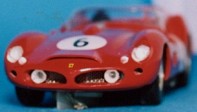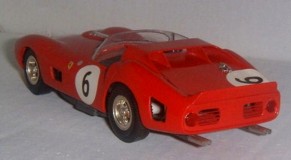This car is the last of the Testa Rossa family (the real ones that
is), a 330 TRI ( I is for independent suspension), the last front
engined car to win Le Mans, in 1962 (until Panoz gets it right). By
then it had a 4-litre engine and looked very different from the 1958
Testa Rossa (as done by Ninco).
Starting
from the Strombecker bodyshell, the work done went as follows:
The
front end.

Plasticard
was fitted to the sides of the car to give it normal wings,
card and Milliput was used to reshape the nose and create the "nostrils",
the air intake on top of the nose was made using shaped card. The
whole nose job was obviously
the most difficult part of the conversion. It was done first in case
it went badly wrong and the car ended up in the reject box.
Once
the nose was of roughly the correct shape, the rest of the work could
be carried out.
The
Tail.
 The
height of the rear wings was increased using Milliput, a piece
of card was glued across the back to form the flat rear deck, another
piece of card was glued at right angle to form the back of the car,
the spoiler was added. The tail of the car is recessed, to achieve
this neatly, a plastic rod was shaped and glued around the edge of
the rear panel.
The
height of the rear wings was increased using Milliput, a piece
of card was glued across the back to form the flat rear deck, another
piece of card was glued at right angle to form the back of the car,
the spoiler was added. The tail of the car is recessed, to achieve
this neatly, a plastic rod was shaped and glued around the edge of
the rear panel.
(picture
by Trevor May)
The
Strombecker cockpit was entirely cut out and replaced with a flat
piece of card, the dashboard was build up from card. The
wing was shaped from plastic card and glued into place.
The
openings were cut into the body, two on each side and two in the back
of the car, not forgetting the one in the bonnet for the carburettors.
 It
was then time to finish the shape of the nose, this is particularly
difficult as it must be symmetrical, having got it nearly right,
but not quite, my bottle went and I put the project down for about
six months (it was near painting stage and I hate painting).Having
sat there for 6 month the unfinished car was spotted by Chris and
David during a visit, this prompted them to indulge in some persistent
arm twisting. In the end, I gave in and decided to restart the project.
It
was then time to finish the shape of the nose, this is particularly
difficult as it must be symmetrical, having got it nearly right,
but not quite, my bottle went and I put the project down for about
six months (it was near painting stage and I hate painting).Having
sat there for 6 month the unfinished car was spotted by Chris and
David during a visit, this prompted them to indulge in some persistent
arm twisting. In the end, I gave in and decided to restart the project.
(picture
by M Gussin)
A
couple of inspired evenings later and the nose shape was just right,
the top of the front wings was modified to match the real car and
it was ready to be painted (panic!).

